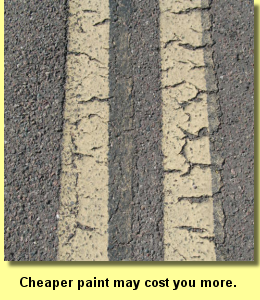 |
 |
Fueling EconomyBy Donna SpeidelI'm always looking for a good deal; I'll scope out the price of gasoline and try to plan an empty tank in an area where it is the least expensive. I assume, naturally, that all gasoline (regular, 87 octane) is about the same; and as long as my car's engine doesn't mind, I continue happily and ignorant of the detailed aspects of the refining process. But when my engine starts to hesitate or sputter, I know I just got what I paid for. I could use a brand name gasoline (other than BP) for a while rather than Acme Fuel Stop, but it sure hurts when I pay that extra eight cents per gallon; why, that's a whole $1.60 more than at Acme! But then I realize my car's engine will cost a lot more if I have to replace it, and better performance and mileage on the highway is well worth paying a few cents more.
It may seem like a real bargain to buy paint at $8.00 or less per gallon, but consider the long-term effects. We have proof that higher quality paint designed for airport use (when properly applied of course) lasts a lot longer; resulting in less maintenance cycles, less build up, and better cost effectiveness. For just another three to five cents a square foot, that's a bargain even I can grasp! |

 There are a lot of things like that. Take traffic paint, for example. There are some suppliers that use fillers, cheaper resins
or cut corners in the refining process that affects the quality of the paint, and eventually the quality and life-cycle of the pavement markings.
On airfields, this is becoming a real problem. The pavement doesn't react as quickly as my car engine does when I use cheap gas; it may take a
while for poor quality paint to crack and peel up; and by then the pavement is also suffering. Like having to replace my car engine, airports may
have to replace their asphalt pavements when the markings pull it apart.
There are a lot of things like that. Take traffic paint, for example. There are some suppliers that use fillers, cheaper resins
or cut corners in the refining process that affects the quality of the paint, and eventually the quality and life-cycle of the pavement markings.
On airfields, this is becoming a real problem. The pavement doesn't react as quickly as my car engine does when I use cheap gas; it may take a
while for poor quality paint to crack and peel up; and by then the pavement is also suffering. Like having to replace my car engine, airports may
have to replace their asphalt pavements when the markings pull it apart.